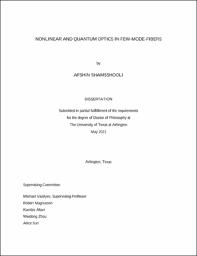
ATTENTION: The works hosted here are being migrated to a new repository that will consolidate resources, improve discoverability, and better show UTA's research impact on the global community. We will update authors as the migration progresses. Please see MavMatrix for more information.
Show simple item record
| dc.creator | Shamsshooli, Afshin | |
| dc.date.accessioned | 2021-06-01T21:03:37Z | |
| dc.date.available | 2021-06-01T21:03:37Z | |
| dc.date.created | 2021-05 | |
| dc.date.issued | 2021-04-22 | |
| dc.date.submitted | May 2021 | |
| dc.identifier.uri | http://hdl.handle.net/10106/29829 | |
| dc.description.abstract | In the absence of quantum repeaters, fiber loss sets the hard limit on secure quantum communication rate. Single-photon source rate decays exponentially with the length of fiber. The only way to scale the rate up is by increasing the number of modes over which the single-photon or entangled states are transmitted, for subsequent use in. quantum communication, computing, or information processing. Entanglement in multiple degrees of freedom, e.g., in polarization, frequency, time-bin, and spatial modes has a potential for carrying larger amounts of quantum information. In this project, we explore spatial modes in the few-mode fiber for generation and processing of spatially-entangled states. There are 2 requirements to use spatial-mode entanglement in quantum communication: 1) Generation of spatially-entangled states, and 2) Mode-selective frequency conversion, which could make alternating projective measurements in mutually unbiased bases (these projective measurements make it possible to decode the information encoded in spatial entanglement). In this thesis, both of these 2 requirements have been addressed via inter-mode four-wave mixing (IM-FWM) in a few-mode fiber.
In the first part of the work, two IM-FWM processes necessary for mode-selective frequency conversion have been implemented, and upconversion of any combination of two signal modes from C-band to fundamental mode in S-band with crosstalk below –20 dB has been experimentally demonstrated. These experiments have been realized in two different mode spaces: one in (LP01, LP11a) mode space, and the other in (LP11a, LP11b) mode space compatible with Orbital-Angular-Momentum (OAM) encoding.
In the second part of the work, in the effort to generate spatially-entangled photon pairs, a combination of two IM-FWM processes that couples an arbitrary two-mode signal combination to an orthogonal idler mode has been demonstrated in a few-mode fiber. When both processes have been combined, it was observed that they couple the input two-mode classical seed signal to an orthogonal two-mode idler for various signal-mode superpositions. This mode anticorrelation between the generated signal and idler beams has been experimentally demonstrated for (LP01, LP11a). We have also demonstrated the coupling between the signal and idler beams in the orthogonal modes of (LP11a, LP11b) mode space, promising the generation of OAM-entangled pairs directly in the few-mode fiber. | |
| dc.format.mimetype | application/pdf | |
| dc.language.iso | en_US | |
| dc.subject | Nonlinear fiber optics | |
| dc.subject | Inter-modal four-wave mixing | |
| dc.subject | Few-mode fibers | |
| dc.subject | Quantum communication | |
| dc.subject | Quantum entanglement | |
| dc.subject | Quantum information processing | |
| dc.subject | Nonlinear-optical signal processing | |
| dc.subject | Wavelength conversion | |
| dc.title | NONLINEAR AND QUANTUM OPTICS IN FEW-MODE-FIBERS | |
| dc.type | Thesis | |
| dc.degree.department | Electrical Engineering | |
| dc.degree.name | Doctor of Philosophy Electrical Engineering | |
| dc.date.updated | 2021-06-01T21:03:37Z | |
| thesis.degree.department | Electrical Engineering | |
| thesis.degree.grantor | The University of Texas at Arlington | |
| thesis.degree.level | Doctoral | |
| thesis.degree.name | Doctor of Philosophy in Electrical Engineering | |
| dc.type.material | text | |
| dc.creator.orcid | 0000-0002-3350-6310 | |
Files in this item
- Name:
- SHAMSSHOOLI-DISSERTATION-2021.pdf
- Size:
- 2.603Mb
- Format:
- PDF
This item appears in the following Collection(s)
Show simple item record


